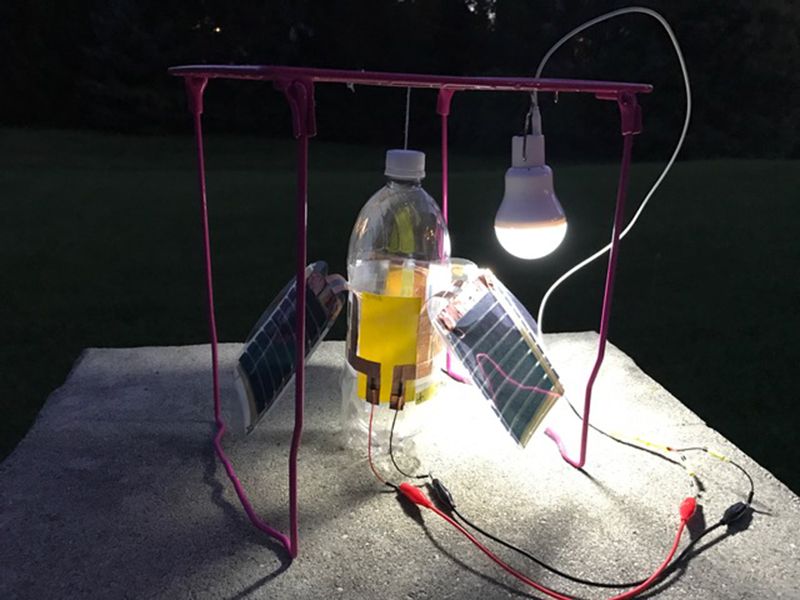The Answer to India’s Energy Crisis Could Be Blowing in the Wind
The 2016 Young Scientist Challenge winner modeled her energy harvester after a tree
/https://tf-cmsv2-smithsonianmag-media.s3.amazonaws.com/filer/21/49/2149003a-5a6c-4984-8da0-d88131cd9bcb/manaasa-mendu-and-harvest.jpg)
On a trip to visit her grandparents in rural India, Maanasa Mendu noticed something that didn’t happen back home. The lights went out. A lot. Almost every day, at six o’clock, the power would cut out, in an attempt to distribute power. It’s a well-known issue there; the term “energy crisis” is often used.
“For me, it’s terrible since I have no access to lighting or air conditioning,” she says. “But I realized that for nearly 1.2 billion people in the world, this type of darkness is a reality for them. And they still use kerosene lighting.”
So Mendu built a prototype renewable energy-gathering device called HARVEST, which mimics the shape of a tree (though much smaller) and uses piezoelectric energy harvesters to capture power from wind and rain.
Last week, Mendu, who is now a ninth grader in Mason, Ohio, was named the winner, out of nine other finalists, of the 2016 Young Scientist Challenge, a national science competition for grades 5-8 that comes with a $25,000 prize.
If that sounds a little like a reality show, that may be because it was hosted by 3M in partnership with Discovery Education.
“I think this really personifies that magic that happens when you provide opportunities to young people to really put their ideas into action, into practice,” says Lori McFarling, a senior vice president at Discovery Education who helps run the challenge.
This isn’t just about celebrating a kid who’s got a great science fair project. Maanasa’s device shows real innovation. It is designed not just to solve a real-world problem but to also be useful and adaptable where the problem occurs. As a finalist in the competition, Mendu took her device through four months of rigorous testing and refinement with the help of a mentor from 3M, senior product development engineer Margaux Mitera.
Mendu had been working with piezoelectric materials—those that generate electricity from mechanical energy—for a couple of years, entering both her 7th and 8th grade science fairs with piezoelectric projects. She noticed that the way the stems of leaves bobbed on trees was similar to the kind of flex that drives piezoelectric harvesters. So she built a mock tree, a small structure with piezoelectric stems and Styrofoam leaves, and made an entry video for the Young Scientist competition.
Mendu talks fast and uses a lot of technical terms. She takes advanced classes in science and math, and does extracurriculars like Science Olympiad. She goes to middle schools to do experiments and demonstrations for the students there.
But the Young Scientist competition was far more in depth and challenging. She spent two to three hours per day, over the summer, learning about renewables, electrical engineering, prototyping, and more.
“She’s got all these great ideas, and this passion and drive for doing all these things,” says mentor Mitera. “What I could help her with was helping her tell her story of how it’s better, different, or going beyond what some of the existing renewable energy sources are today.”

After discussing the practical requirements of a renewable energy source, Mendu decided to integrate flexible solar cells into the device. Now it looks something like a rocket. A plastic water bottle at the center provides the structure, and three wings extend off of it. These mimic the leaves on a tree, vibrating in wind or rain, and powering the piezoelectrics. But now the leaves are made from solar foil, an organic photovoltaic from 3M, which Mendu wired into the same circuit to increase the current. Piezoelectrics are a good source of voltage, but offer little current, and photovoltaics can help supplement that. The piezoelectric harvesters activate in the rain and wind, the solar foil in the sun. The device can hang almost anywhere, and Mendu has successfully charged an iPhone 5, and powered a 15-watt LED bulb.
The leaves, in this case, are far more important than the trunk. Mendu says the little structures could be placed individually, as modular, customizable leaf-like appendages, on buildings or other structures.

“I really want to see its application onto possibly the surface of buildings in urban areas to integrate green energy harvesting into our urban environment or in rural areas to power a localized source of power in emergency situations or in developing countries,” she says.
Maybe then she’ll get to some of her other projects—a desalination system for reverse osmosis water purification, or piezoelectric harvesting devices housed in tires.
“There are so many problems in our world,” she says. “If you just take the time to look at them, you’ll have so many ideas.”

